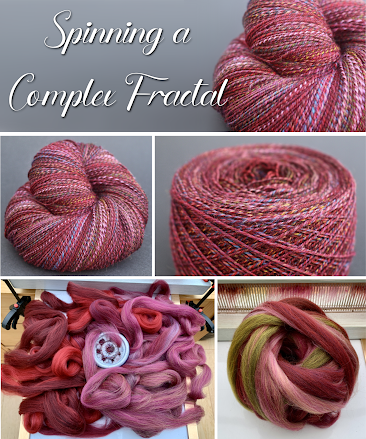Like a lot of spinners, I love exploring colour theory by mixing primary colours to make my own heathered blends. I enjoy trying to colour match specific hues using just 4 or 5 basic colours. In searching for the ideal primaries I’ve ended up with a small collection of dyed merino wool, from various mills, that don’t quite make the perfect starter colours.
To spin this yarn I’ll be using up two of these ‘almost’ primary colours -
 |
| Image copyright Wingham Wool |
Magenta from Wingham Wool is a lovely deep saturated, magenta but it’s a little too dark and too purple to be the ideal primary colour. Blending it with yellow gives you a slightly muddy orange or red - which is great if you’re looking to blend autumnal shades but not as a primary colour.
 |
| Image copyright John Arbon Textiles |
This is yellow from John Arbon. It’s a beautiful, warm sunny yellow and is a better primary colour than the magenta but it’s still ever so slightly orange.
Last year I linear blended these two colours together in 20 steps to see how close I would get to red. Not being perfect primary colours, they gave me a slightly muddy autumnal colour palette. I loved the warm colours I achieved, especially those rusty, orange/reds closer to the magenta end - so I thought I would try to reproduce some of those cosy, warm colour blends to spin a very wearable yarn.
I blended the fibres above thoroughly using my mini wool combs to get homogeneous blends. I’m less concerned about completely mixing the colours together so this time, I’ll be using a blending board to quickly blend these two shades of merino to give me a more complex two-tone yarn.
It will be interesting to see what colours I achieve purely through optical blending.
For a closer look at some of my techniques, I've made a video to show my process in more detail.
This animated gif has been sped up by 400% but you can see that I lay the magenta merino fibres onto my blending board by drafting them on using the edge of my blending board brush. I’m trying to cover the whole of the board while still drafting the magenta as thinly as possible.
Next, I added the yellow. I want a little less of this colour so I’m trying to draft it out even more thinly.
I then repeated the same two processes once more and then finished with a final layer of magenta.
Instead of drafting off rolags to spin a fluffy woollen-spun yarn, I wanted a slightly smoother, worsted-style yarn so I went on to turn the blending board batt into a kind of semi-worsted prepped roving. (I realise that worsted and roving are quite contradictory fibre terms but I do like to be contrary from time to time …)
I removed the whole blending board batt in one piece, taking care not to draft it out at all.
I then went on to zed-strip or zigzag strip it.
Finally, I drafted it all out, taking care at the edges to try to re-orientate the fibres so that they were mostly running parallel with the edge of the roving.
It looks almost like combed top but it has the fluffiness of roving!
I repeated this process several times until I’d spun about 130g of singles on my Electric Eel Wheel 6 (affiliate link).
I'll be chain-plying the singles to minimise wastage to get a lovely round sport-weight yarn. Despite the fact that I drafted the colours quite thinly onto my blending board, I've still got a few sections that are yellower than I would like. If I were to chain-ply this at the wheel it is very likely to accentuate these sections rather than dilute them.
To combat this issue, I pre-chain-plied the singles to maximise the amount of colour blending I achieved. You can read about the two ways to chain-ply in this blog post.
I love the effect you get from pre-chain-plying sometimes. Those long yellow sections that I had been concerned about have mostly optically blended into orange.
It's so pretty!
Thank you so much for reading, and happy spinning!
If you've found any of this post interesting or useful, please pin this image to Pinterest. It makes a big difference to me and helps other spinners find it too.
At this point, I normally suggest similar related blog posts, however, my list of spinning-related content is becoming a little unmanageable... If you'd like to read more blog posts about spinning and fibre preparation, please take a look at this page here where you will find links to all of my spinning and fibre articles.
Thank you for reading, and happy spinning!
----------
Please be sweet and share the love. Leave a comment, subscribe to my YouTube channel, like my Facebook page for regular updates or follow me on Pinterest, Bloglovin' or Instagram





















No comments:
Post a Comment